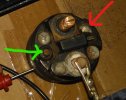As you have a 74 you already have a starter relay in the car with a push button in the engine bay to engage the starter. You should be able to use this existing system by bridging the seatbelt interlock system to take that part of the connections out of the loop.
This thread covers using what you have to make what you need:
Have both a question but also trying to document for future searches so links and pictures come up in one place. The seat belt interlock, unique to 1974 and very early 1975 cars, have two (?) relays and controller tucked under the passenger side dash as pictured here. Uploaded with...
xwebforums.com
This image is the critical one which changes the system to just be a starter relay:
View attachment 71062
You shouldn’t have to add anything to your car beyond connecting two existing wires directly to each other near the drivers seat belt buckle assembly.
However if the gnome who effed with your car did not understand this system and bypassed it entirely you have some work cut out for you.
For most X owners the following is what they would do to add a hard start relay:
This is what most X1/9s have: the battery which has two sets of wires attached to it, a negative which is bolted directly to the body and a positive heavy wire that goes directly to the starter (along with several smaller wires which bring power to all the other systems in your car). You have the ignition switch which receives power from the battery and when you turn the key to the start position now directs some of that power to a 10ga wire that runs from the switch, along the main tunnel and to the starter solenoid. When the wire has power to the solenoid it engages a winding in the solenoid which pushes the starter gear forward to engage the flywheel and second winding engages the 300 or so amps to the starter motor which will spin the gear engaged to the flywheel and hopefully your engine will start.
View attachment 71058
What you will be doing: Adding a relay between the ignition switch and the solenoid, getting power directly from the starter main lug to go to the 30 terminal of the relay with a new wire (with an inline fuse if you so desire), using the existing wire from the ignition switch to excite the relay, a wire to ground the relay and finally a new wire from the 87 terminal to the existing spade connection on the starter which used to have the wire from the ignition switch.
View attachment 71059
The fuse is optional, the existing circuit is not fused but if you want an additional safety step the new wire from the main lug of the starter to the relay can have a 30amp fuse.
What you will be making (roughly)
View attachment 71060
Personally I would put the relay inside the spare tire area high on the right side wall when facing the spare tire. I don’t like having relays in the weather.
The relay connections (rough because I need to go to work)
View attachment 71061
The wire from the ignition switch can be separated out of the wire loom in the spare tire compartment to got to the 86 terminal on the relay. The other three wires will be added.


